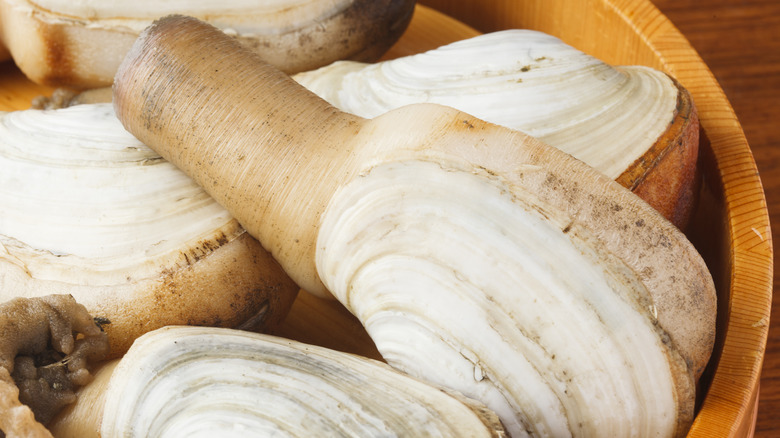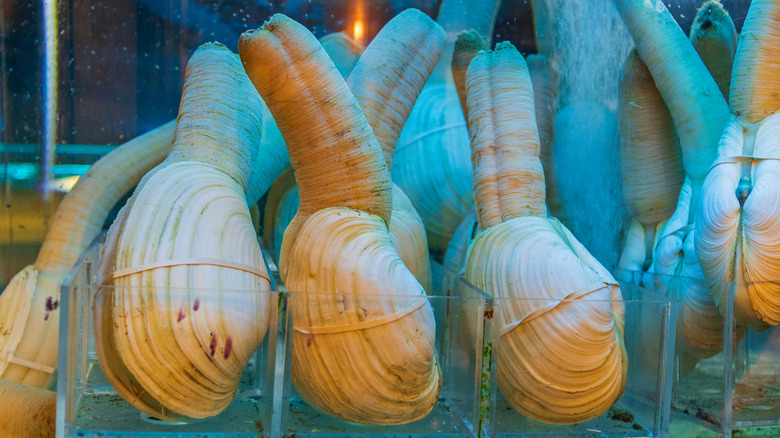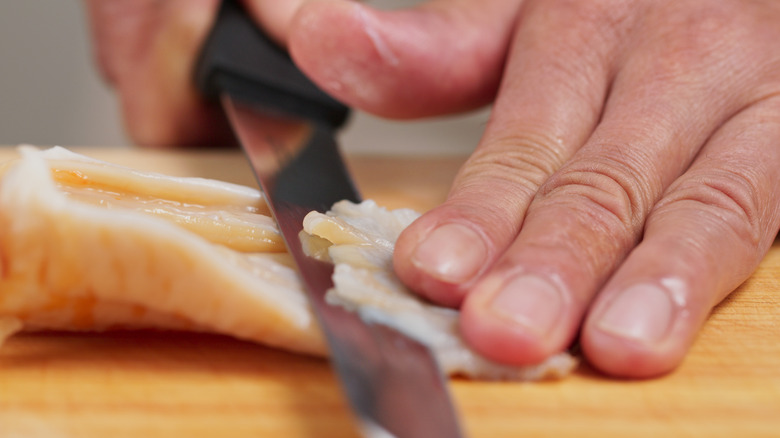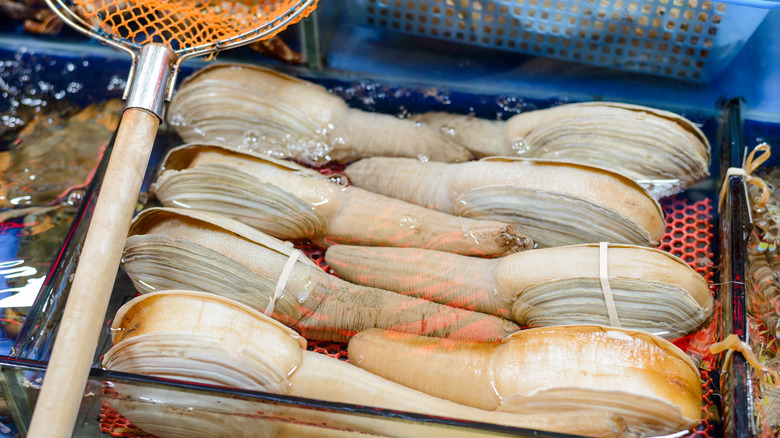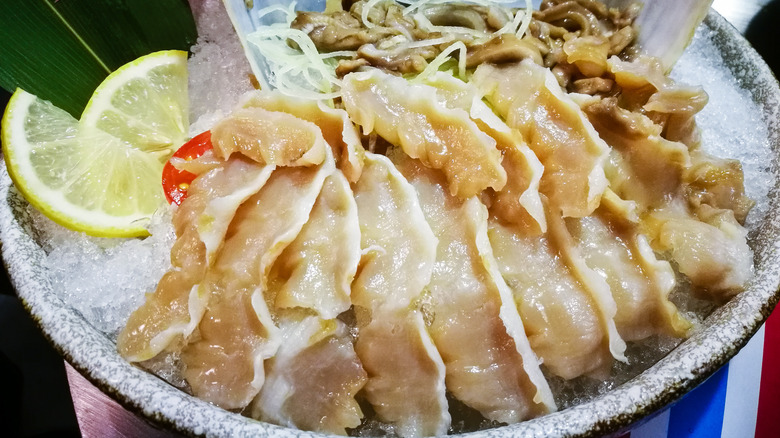The Truth About Geoducks
The geoduck is every bit as out-of-the-ordinary as its unique name suggests. Pronounced "gooey duck," this bizarre-looking shellfish has become a food media darling with appearances on shows such as "Top Chef," "Chopped," and "Bizarre Foods with Andrew Zimmern." If you have never heard of or seen a geoduck before, that's quite understandable. The hefty saltwater clam is native to very specific regions — the Pacific Northwest, where U.S. geoduck consumption is most prevalent, and the western coast of Canada (via Eater).
The geoduck is also considered a delicacy, with prices for the seafood going up to as much as $150 per pound, according to Oceana, an international non-profit organization for ocean advocacy. In fact, Smithsonian Magazine described it as so profitable and valuable that "gangsters have traded it for narcotics," so you're highly unlikely to find it at your average run-of-the-mill grocery store or seafood market, especially outside of the West Coast.
What is a geoduck?
Geoduck (Panopea generosa) is a saltwater clam with a neck so long it cannot retract into its shell, according to Oceana. The anatomy of a geoduck, the world's largest burrowing clam, is fairly simple. In addition to the neck hanging out of its shell, it has a meaty part, called a mantle or breast, inside the shell, as reported by Eater. Oceana stated that while the shell rarely grows larger than eight inches, the soft body can be over three feet long, and that the mollusk has a significantly long lifespan, even reaching over 165 years old.
The massive shellfish is highly prized in Japan, Korea, and China, where it is considered an aphrodisiac. Consumers in these Asian countries find the taste of geoduck so delicious that most of the clams harvested stateside are sold overseas. More than 90% are "flown straight to China and Hong Kong," as reported by BBC News. The immense enthusiasm for the geoduck in the Pacific Northwest and beyond proves that while the mollusk may not be the prettiest of them all, it certainly has flavor worth raving about.
What does geoduck taste like?
Buying a geoduck is like getting two different meats for the price of one. According to The New York Times, the neck and body of the geoduck are very different. After being pounded until it is 1/16th of an inch thick, the neck meat is white and crunchy under the yellow skin and has a "sea flavor." The body meat, on the other hand, is darker, more tender, and richer in flavor. If raw, the body meat has a "clear, tangy flavor," but if cooked, it resembles a "mild, rich clam" (via The New York Times). The meat of the neck and body both get tougher the longer they are cooked, according to the Times.
Gastro Obscura described geoduck meat as "sweet and briny" without being fishy, with a "clean, snappy bite that's much crisper than other clams," leading many to consider it to be the ideal seafood. Of course, a reputation for being a superior seafood doesn't come without a steeper price tag. The website notes that the geoduck is, by weight, worth more than foie gras.
Where to buy geoduck
Northwesterners take a lot of pride in the geoduck. Award-winning Seattle chef and restaurateur Ethan Stowell told Serious Eats that the taste of fresh, raw geoduck is "what every piece of seafood should be." He also told the publication that "something so specific to the Northwest as geoduck demands a level of respect. Anywhere you eat good geoduck, it comes from here, helping to illustrate that the Northwest is an awesome place to cook, live, and eat."
Even the name geoduck is deeply rooted in the culture of the region, where Native American Salish tribes gave the clam its moniker, a derivation of gweduc, which means "dig deep" in the Lushootseed language, according to Gastro Obscura. They are so deep, in fact, that some geoduck hunters use plastic tubes that go into the ground to uncover the clams, according to Eater. Love for the geoduck has moved beyond the food scene in the state of Washington, where Evergreen State College in Olympia claims the delectable shellfish as its official mascot.
If you don't live in the Northwest or near a seafood market that carries these shelled behemoths, you can buy them fresh or frozen online. Or, you might be able to find it on a restaurant menu, especially if you're headed to China, Korea, or Japan.
How is geoduck prepared?
According to Eater, in the Pacific Northwest, you can find geoduck prepared as a ceviche or sushi, chowder, crudo, or even savory pie like in Art of the Pie's Big Clam Pie recipe. In Japan, it's common to see geoduck used for sashimi and sushi, where it may be referred to as "mirugai," meaning giant clam (via Sushi Geek), but this may be a substitution for another clam. According to Asahi, "mirugai" refers to the gaper clam, another premium shellfish produced in Atsumi Peninsula, Tokyo Bay, and the Seto Inland Sea. You can find chefs in Korea serving the clam raw with hot chili sauce, or in soups and stir-fried dishes. And you can enjoy it as a hot pot ingredient in China.
If you're going the brave route, and bringing home live geoduck, don't store it on ice. According to Chefsteps, geoducks will die in freezing temperatures. Instead, the outlet recommends simply storing them in the refrigerator. Blanching is also recommended, as well as trimming the end of the siphon for a cleaner presentation. After the meat is trimmed and cleaned, the geoduck can be eaten raw. Or, if you prefer a little more cook time for your shellfish, you can try out their recipe for their Home Clam Bake. Just let us know what time to be there!
